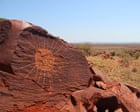Australia’s environment minister, Murray Watt, has lobbied national Unesco ambassadors in a bid to overturn a recommendation that ancient rock art in Western Australia’s north-west should not receive world heritage listing unless nearby industrial facilities shut down.
Delegations from the Australian government and the Murujuga Aboriginal Corporation, a body established to represent five traditional Indigenous language groups,plan to attend a Unesco meeting in Paris next monthto argue for an immediate world heritage listing for the Murujuga cultural landscape.
The ramped up lobbying campaign follows the UN body last month finding facilities – including Woodside Energy’s controversial North West Shelf gas processing plant –needed to be removed from the regionif Australia wanted to win world heritage listing for more than a million petroglyphs, some nearly 50,000 years old.
TheUnescorecommendationfollowed advice from the International Council on Monuments and Sites that, while Murujuga met the main requirements for a world heritage listing, industrial pollution was making the “integrity and the authenticity of key attributes…highly vulnerable”.
Speaking to Guardian Australia, Watt repeated his claim that the Unesco report included “factual inaccuracies” and said the authors did not have access to “the latest evidence”, including a rock art monitoring report compiled last year and released by the WA government in May.
Watt claimed the recommendation had been “clearly influenced by some campaign efforts” by environment organisations. “Our view was that the decision was overly influenced by that kind of political activity rather than the scientific evidence, and rather than the wishes of the traditional owners,” he said.
“I think they’re the kind of things that should come first.”
Watt said he had “personally lobbied a number of Unesco ambassadors who will be making this decision” ata UN Oceans Conference in France last week. “Obviously, our government officials are doing that as well. I would say we got a good hearing on our points. I wouldn’t say that people have decided. They’re obviously going to have to think about it and consider the evidence, but we’ll be lobbying hard in favour of the listing,” he said.
The Unesco report was released just hours before Watt announcedhe planned to approve Woodside’s application to extend the life of the North West Shelf development– one of the world’s biggest liquified natural gas projects – from 2030 to 2070. It followed the proposal receiving approval from the WA government in December.
The decisions have been criticised by environment organisations, academic researchers and the traditional custodians body Save Our Songlines on two grounds: the potential impact of local air pollution on the culturally important rock art and the billions of tonnes of greenhouse emissions that could result from gas produced at the plant.
The group Friends of Australian Rock Art has launched a bid in the WA supreme court to challenge the state government’s approval decision.
Watt was not required to consider greenhouse gas emissions as climate impact is not grounds to refuse or limit a development application under Australia’s national environment law. The government says it deals with industrial emissions under itssafeguard mechanism policy.
On rock art, the minister said his proposed approval included “strict conditions” relating to local air emissions that could affect Murujuga rock art. The conditions have not been made public and Woodside was given 10 days to respond to them. That time has since been extended.
Prof Benjamin Smith, an archaeologist and rock art expert at the University of Western Australia, criticised the decision and the WA government’s rock art monitoring report. He said a government summary of the report incorrectly claimed most existing damage to petroglyphs from industrial pollution occurred in the 1970s and 1980s and that key pollutant levels had declined since 2014. He claimed scientists who worked on the report were being gagged so they couldn’t raise their concerns about how their data was being interpreted.
Watt said the conditional approval decision had “not been blind to potential impacts on the rock art. In fact, that was the entire basis of the decision”. Watt said if Murujuga received world heritage listing it would “add another layer of protection to ensure that it is cared for into the future”.
He argued there had been a “concerted campaign” by some environment groups to discredit the rock art monitoring report, but one of its authors, Prof Ben Mullins, had told the ABCthat he agreed with the public interpretation of its findings. “I think, unfortunately, this issue has become politicised, and what’s really important is that we all take a step back and listen to the views of the traditional owners,” Watt said.
“Yes, there are some individuals who are not supporting the listing. But the representative body for the traditional owner groups is not just supporting their application, they’re leading it.”
The chair of the Murujuga Aboriginal Corporation, Peter Hicks, said “misinformation, misrepresentation and statements that are simply untrue” over the state of rock art protection had led to “grief and sadness in our communities”.
“We co-exist with industry and support the science,” he said. “As the traditional owners, we have every confidence that the Murujuga rock art will continue to endure for thousands of years.”
The Unesco recommendation is due to go before the 21-country world heritage committee on 6 July.
